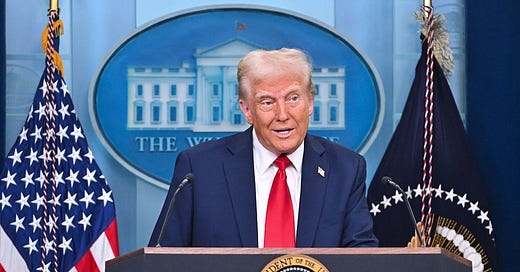Donald Trump's Big Economy Fix
The return of DJT means the economy will roar again, but it will take some time
As we approach the quarter mark of Trump’s second first 100 days in office, one of the most pressing issues for Americans remains the economy. As such, the current state of the economy was a major reason why DJT returned to the White House. Inflation has eroded purchasing power, supply chain disruptions persist, and wages for many have stagnated relative to the rising cost of living. Even worse, job seekers are finding it nearly impossible to find fulfilling work. Amid all of this uncertainty, DJT has presented himself as the leader capable of restoring economic stability and prosperity. Trump’s track record during his first term and his proposed policies for his second term offer a blueprint for revitalizing the economy.
One of Trump’s cornerstone economic achievements during his first term was achieving energy independence. By rolling back restrictive regulations and unleashing domestic energy production, the U.S. became a net exporter of energy for the first time in decades. This policy not only created high-paying jobs in the energy sector but also reduced reliance on foreign oil, insulating the U.S. from geopolitical energy shocks. There is no doubt America will achieve energy independence once again under a second Trump term. Energy independence will save taxpayers a boatload of money.
Trump’s energy plan for a second term aims to build on this success. He has pledged to reopen federal lands for drilling (#DrillBabyDrill), fast-track pipeline approvals, and invest in refining capacity to ensure stable energy supplies. With energy prices being a key driver of inflation, this strategy could provide immediate relief to consumers while boosting industrial competitiveness by lowering input costs for manufacturers.
The Tax Cuts and Jobs Act (TCJA) of 2017 was one of Trump’s signature legislative accomplishments. Initially set to expire in 2025, the TCJA is now poised for renewal, ensuring its benefits can continue to provide economic relief. By lowering corporate tax rates and allowing for full expensing of capital investments, the TCJA spurred business investment and economic growth. Middle-class families also benefited from increased standard deductions and lower individual tax rates. If the Democrats retained the White House, this key legislative win by Trump would be nullified, raising taxes for the middle class.
Trump has signaled his intent to build on the TCJA by making individual tax cuts permanent and introducing additional incentives for small businesses. Deregulation, another hallmark of his first term, will also take center stage. Trump has vowed to eliminate bureaucratic hurdles that stifle entrepreneurship, particularly in sectors like manufacturing, construction, and technology. By reducing the compliance burden on businesses, he aims to unleash innovation and job creation.
Trump’s “America First” economic agenda has always prioritized domestic manufacturing. During his first term, tariffs on Chinese imports and incentives for reshoring production led to a resurgence in American manufacturing jobs. However, the COVID-19 pandemic exposed vulnerabilities in global supply chains, particularly for critical industries like pharmaceuticals and semiconductors.
A second Trump administration would likely double down on reshoring efforts. Proposals include tax credits for companies that bring production back to the U.S., penalties for outsourcing to adversarial nations, and strategic investments in industries deemed essential to national security. By fostering a robust domestic manufacturing base, Trump aims to create high-quality jobs and reduce dependence on foreign suppliers.
Runaway inflation has been one of the defining economic challenges of recent years. While monetary policy falls under the purview of the Federal Reserve, fiscal policy can play a significant role in curbing inflationary pressures. Trump’s approach focuses on addressing the supply side of the equation by increasing domestic production, particularly in energy and manufacturing, as well as reducing regulatory barriers that drive up costs.
\Additionally, Trump has expressed skepticism toward excessive government spending, particularly on programs he views as inefficient or wasteful. These types of excessive spending include sending millions of dollars to foreign countries that hate America, and pay raises for members of Congress. By curtailing unnecessary expenditures and focusing on targeted investments, he aims to reduce the federal deficit and alleviate inflationary pressures.
During his first term, Trump renegotiated trade agreements to prioritize American workers and industries. The United States-Mexico-Canada Agreement (USMCA), which replaced NAFTA, included provisions to protect domestic manufacturing and incentivize higher wages for workers. Tariffs on China, while controversial, highlighted the need to address unfair trade practices and intellectual property theft. Trump has also expressed interest in renaming the Gulf of Mexico to the Gulf of America, signaling his commitment to bolstering American identity and sovereignty.
Trump’s trade agenda will emphasize bilateral agreements and prioritize reciprocity and fairness. By leveraging the U.S.’s economic power, he seeks to secure deals that open foreign markets to American goods while protecting critical industries from unfair competition. This approach is designed to create jobs, boost exports, and reduce the trade deficit.
A Trump administration immigration policy has both economic and social implications. Trump’s stance has consistently emphasized border security and merit-based immigration. By curbing illegal immigration, DJT aims to reduce downward pressure on wages and ensure that jobs are available for American workers. At the same time, Trump has advocated for a merit-based immigration system that prioritizes skilled workers who can contribute to key industries.
This dual approach seeks to address labor shortages in sectors like technology and healthcare while safeguarding opportunities for U.S. citizens. By aligning immigration policy with economic needs, Trump hopes to foster a balanced labor market that drives growth.
The U.S. has long been a global leader in innovation, but maintaining that edge requires continuous investment in research and development. Trump’s economic policies include incentives for technological advancements, particularly in areas like artificial intelligence, biotechnology, and renewable energy. By fostering public-private partnerships and reducing regulatory barriers, he aims to position the U.S. as a hub for cutting-edge innovation.
Additionally, Trump has pledged to address the regulatory challenges faced by emerging industries, such as cryptocurrency and autonomous vehicles. By providing clear guidelines and a supportive environment, he seeks to unlock the economic potential of these technologies while ensuring consumer protection.
Donald Trump’s economic vision for his second term is rooted in the principles that defined his first: deregulation, tax cuts, energy independence, and a focus on American workers. By addressing inflation, revitalizing domestic manufacturing, and fostering innovation, Trump aims to restore economic stability and set the stage for long-term growth.
Many of Trump's critics will constantly question the feasibility of his proposals or the potential consequences of his trade policies. However, Trump’s track record suggests a commitment to bold action and a results-oriented approach. For millions of Americans grappling with economic uncertainty, DJT’s policies offer a roadmap for a brighter future. This issue will undoubtedly shape the economic debate for years to come.
To learn more about my work, please visit my website.








Any update on this summary? Cause 2 weeks later it sounds like hot air.